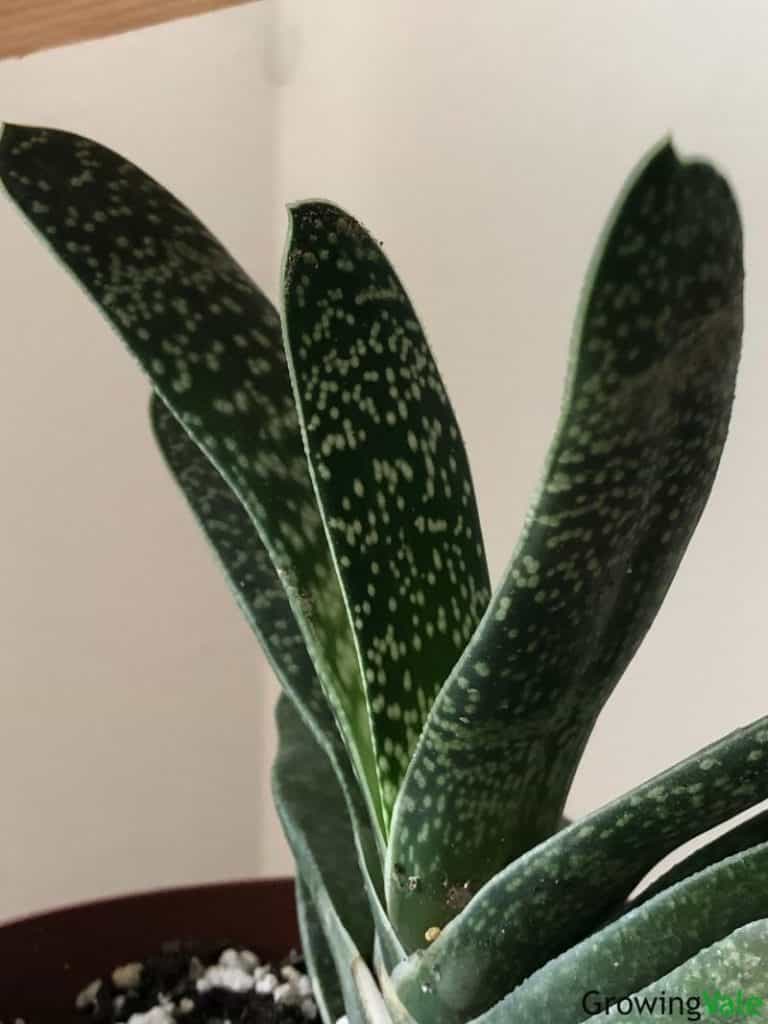Gasteria succulents are quite rare and similar to Aloe. They’re native to South Africa and many of the species have thick, succulent leaves that have a rough texture. That’s why these plants are commonly called ox tongue or cow’s tongue.
These leaves usually have interesting markings such as white spots, warts or attractive bands. Their arrangement is typically linear (distichous) but over time, these can grow to form loose rosettes.
Unlike many other types of succulents, this genus of plants can tolerate lower light conditions and don’t have to be grown in full sun. These are slow-growing plants and most of them are quite small. This makes Gasteria succulent perfect for growing in pretty containers or pots indoors.
Once these plants reach maturity, you can expect to see long, curved, tubular flowers that will appear in winter and spring. Generally, these flowers appear on fairly long stalks that tower over the rest of the plant.
History
The name Gasteria comes from the Greek “gaster” which means stomach and refers to the shape of the flowers on these plants. It’s not actually clear how many species are in this genus. Some say that there are around 16 species while other reliable sources have identified around 40 different species.
In fact, there are two species that have been found growing outside of South Africa. One in Namibia and one in Swaziland.
These plants were first discovered in the 1680s by Hendrik Oldenhand. However, he referred to them as Aloes. In 1809, Henri Duval suggested that these plants should be named Gasteria after studying 3 species that were named Aloe carinata, Aloe disticha and Aloe verrucosa at the time. It took until 1812 for the new name to be first publicized by Adrian Haworth.
Plant Facts
| Scientific name | Gasteria spp. |
| Common names | Ox tongue plant, cow’s tongue, cattle tongue |
| Genus | Gasteria |
| Family | Aloaceae |
| Height | 4 to 24 inches |
| Width | Up to 48 inches |
| USDA Plant Hardiness Zone | 9 to 11 |
| Origin | South Africa |
| Flower colors | Red and pink |
| Blooming season | Winter and spring |
| Plant/Flower special features | The flowers are edible and can be eaten raw or cooked. |
How to Plant and Grow Gasteria Succulent
Most people prefer to grow their Gasterias indoors in a bright room but out of direct sunlight. However, if you happen to live in USDA hardiness zones 9 to 11, you can also grow these plants outdoors. Choose a spot that has well-drained soil and dappled sunlight. Underneath deciduous trees is perfect for these plants.
When growing in pots, make sure that you choose a container that has plenty of drainage holes. Unglazed terra cotta pots are ideal for these succulents as they aid in the drainage.
Remember too, that Gasterias have a fairly shallow root system so you can choose some lovely shallow pots to grow your plants in.
How to Propagate Gasteria
One of the easiest ways to propagate new Gasteria plants is by using offsets. These generally grow at the base of the mother plant.
Here’s what to do:
- Carefully remove a few offsets with a sharp knife or a pair of secateurs. You want to cut these as close to the parent stem as possible without damaging the main stem in the process. It’s ideal if the offsets also have a few roots attached.
- Leave these in a dry spot for at least a few hours so that the cut end dries and calluses.
- Fill some small pots or a seedling tray with some cactus or succulent mix.
- Plant the offsets in the pots or the tray and moisten the soil.
- Keep your seedlings in a warm, bright spot out of direct sunlight.
- Ensure that the soil is kept evenly moist until you start to see some new growth on the little plants.
It’s also possible to propagate new plants using just single leaves and the same process as that for offsets.

Care and Maintenance
These succulents are very easy to look after. You only need to water when the soil has dried out and avoid overwatering at all cost. Choose a loose soil mix that is free-draining and fertilize once a year in spring.
Soil
It goes without saying that these plants need to grow in well-drained soil to avoid any possibility of root rot. If your plant is growing in a pot or container, it’s best to use a proprietary cactus or succulent mix. You can even add some sand or perlite to the mix to aid in the drainage.
Outdoors, your Gasterias really need to be grown in a sandy soil that is completely free-draining. You can even consider mounding the soil up a little to assist adequate drainage.
Water
Gasterias only need to be watered when the soil has dried out completely. Because of their thick, fleshy leaves, these plants can hold a lot of moisture. Bear in mind that the leaves don’t like to be wet as this can cause them to rot.
Therefore, you only ever want to water these plants at the soil level. This means that planting your succulents under trees in USDA zones 9 to 11 will provide them with lots of shelter during rainy days.
Fertilizer
You only need to fertilize your Gasterias once a year in spring. Use a diluted cactus fertilizer or a liquid fertilizer at half-strength. You can also think about adding a little extra organic matter into their soil before planting but make sure that the soil remains free-draining.
Sunlight
Although Gasterias do like bright light, they don’t appreciate growing in full sun as this can easily burn the leaves. They should definitely be protected from the harsh midday and afternoon sun.
If you notice the leaves of your Gasteria plant turning white or yellow, it means that the plant is getting too much sun so you’ll have to move it to a shadier location.
Temperature and Humidity
Originating from South Africa, these plants prefer warm temperatures above 50 degrees Fahrenheit (10 degrees Celsius). It should be noted that these succulents are definitely not frost tolerant and a sudden, unexpected frost will likely kill them.
These plants also don’t need a humid environment to thrive and grow. However, if you do live in a humid climate, be very careful about not overwatering them. This is because they’re likely to get all the moisture that they need from the humidity in the air.
Pruning
There’s really no need to prune these plants. However, if they start to look overcrowded in their pot, you can simply remove some of the new offsets and use these to propagate additional plants.
Pest and diseases
One thing to watch out for on these plants is fungal infections. These can appear as black spots on the leaves and can be treated with a fungicidal soap mixture. Fungal infections are often the result of water sitting on the leaves.
Uses of Gasteria
Although these plants are mostly grown for their ornamental value, the flowers are actually edible. They can be eaten raw or cooked and are a great addition to stews.
Common Varieties and Cultivars
It’s not actually clear how many species of plants are in the Gasteria genus. This is mainly due to the fact that these plants were first referred to as Aloes. Another interesting situation arises when these plants are hybridized and new species are created in cultivation.
Apparently, Gasterias hybridize quite well with both Aloes and Haworthia, even when growing naturally. This only adds to the confusion, especially when new species are discovered.
Here a just a few species that we’re aware of:
- Gasteria croucheri
- Gasteria pillansii
- Gasteria acinacifolia var. venusta
- Gasteria ellaphieae
- Gasteria carinata (Bredasdorp Gasteria)
- Gasteria disticha
- Gasteria polita
- Gasteria variegata
- Gasteria excelsa
- Gasteria vlokii
- Gasteria trigona
- Gasteria batesiana (Knoppies Gasteria)
- Gasteria nitida var. armstrongii
- Gasteria nitida (Bathurst Gasteria)
- Gasteria bicolor var. liliputana (Dwarf Gasteria)
- Gasteria ‘Little Warty’
- Gasteria bicolor (Lawyer’s Tongue)
- Gasteria verrucosa
- Gasteria maculata
- Gasteria glomerata
Conclusion
Gasteria succulents are delightful succulent plants to add to your collection. They are extremely easy to take care of, especially if you remember not to overwater them. Due to their small growth habit and ease of care, they’re ideally suited to growing indoors in attractive shallow pots and containers.

